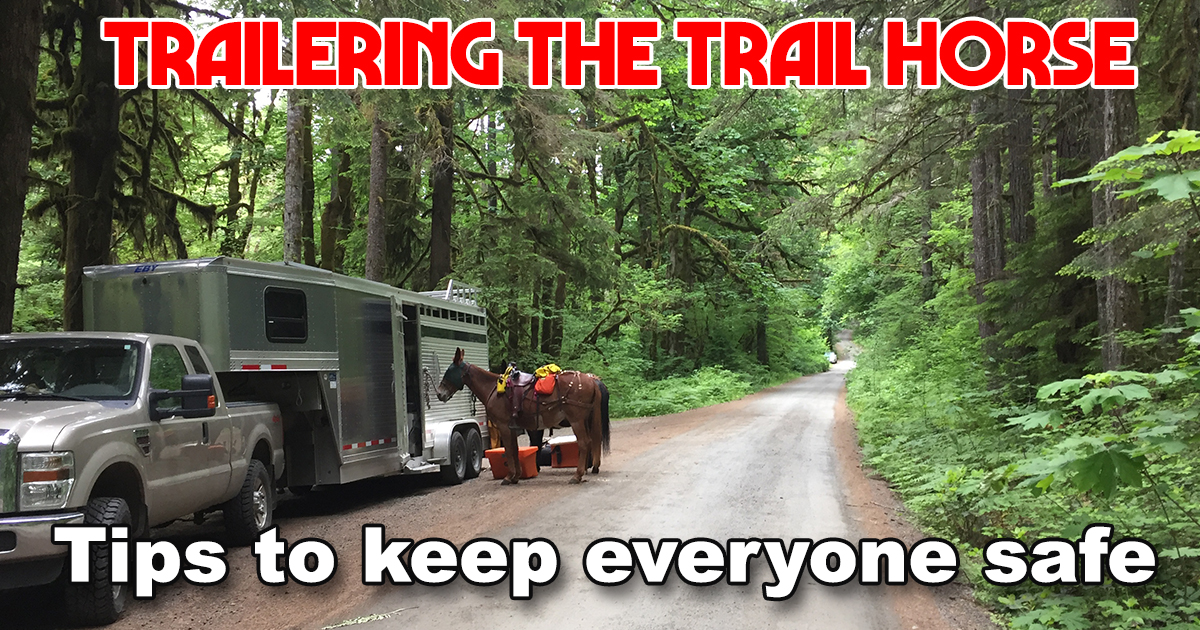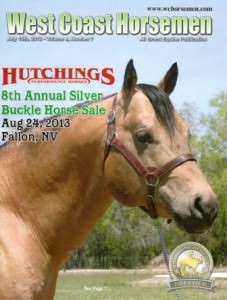Trailering the Trail Horse
As published in the July 2013, issue of West Coast Horsemen Magazine
Summer’s here and with it trail riding. Unless you’re one of the fortunate few that has immediate access to trails you most likely have to load your mounts and haul to the trails. With that in mind let’s take a moment to consider what goes into hauling our horses and mules.
The effort involved with towing starts long before we arrive at the trail head or even hook up the trailer. Consider the training aspect of trailering a horse. Just as we might not enjoy riding down the road in a noisy, bumpy, and drafty trailer, most horses tend to be a bit leery of this dark box, fortunately given enough time and patience most equines learn to tolerate the process.
Most of us have had experience with a horse that refuses to load or races out of the trailer. Practice obedience and calmness by asking him to walk forward, stand quietly, and back up on your command. The objective is for your horse to walk quietly into the trailer, stand there for a bit, and then calmly back out on your command. How long it takes to get here depends on you and your horse. Teaching your horse to load takes patience, trust and much groundwork before he’ll be a consistent loader. But once that happens he’ll step into any trailer when asked and unload easily and relaxed when you arrive at the trailhead. Quiet and confident trailering equates into a pleasure ride for both of you.
The second part of trailering involves the difference between jumping into the car for a quick drive to the grocery and hauling to your favorite trailhead. Once you are out on the open road, the driving task seems almost the same as driving the family car, but it’s what happens at either end of the trip that cause white knuckles for the first-time horse trailer driver. With many favorite horse-camping areas located well off the beaten path and perhaps up, or down, a steep hill; now is a great time to prepare yourself by thinking about how you should approach the task.
Here’s a quick tip to help take the pucker out of the drive.
• The proper use of your brakes while descending a grade is to not use them.
It may be counterintuitive but your brakes are not there to help you maintain a safe speed of descent. Brakes should only be used to slow you down enough to “grab a lower gear.” Though your truck and trailer weigh many times that of a car their brake surface area is only slightly larger. Therefore a very different driving technique is needed. The goal is to use your transmission to slow down and to use the correct gear to hold your speed in equilibrium; neither gaining nor loosing speed. That could mean 1st or 2nd gear, or even the 4WD low range. It’s very easy to fall into the habit of driving your rig just like you would drive a car; with your foot on either the gas pedal or the brake pedal. Driving with a trailer in this manner will quickly wear out your brakes and could very possibly compromise your safety.
The third piece of the trailering puzzle is how we can create an equine friendly environment while we roll down the road. There are many topics to discuss but today we’ll narrow our focus and concentrate on two factors; dealing with heat and our driving style. Regardless of how far we haul we’re asking a lot of our horses and we’re creating stress on them in several ways; from the interior heat of the trailer to being bounced around inside the trailer.
Summer heat is a very real concern when trailering. Most horses’ comfort range is between 30 to 75 degrees depending upon the breed. Now consider the trailer and how hot it can become on a warm sunny (think perfect riding weather) day. Studies have shown that temperatures inside trailers can easily be 10 to 15 degrees greater than outside temperatures. That perfect 80 degree day just became a hot and humid 95 plus degrees inside the trailer. In order to ease heat stress on your animals take the following precautions.
• Select departure/arrival time schedules to avoid the hottest parts of day (i.e. leave early when it’s still cool).
• Ensure your horse is well hydrated beforehand and offer water frequently (at least every 4-6 hours) during longer trips.
• Keep the trailer moving and avoid parking for long periods. The wind’s cooling effect is very helpful so keep those vents and windows open. This also requires you to check road conditions prior to the trip to avoid congested areas. Your driving habits are a huge factor in a comfortable trip for your horse. Towing a horse trailer is, as you already know, very different than going for a Sunday drive in your car. Trailers are long, heavy, and loaded with precious cargo. Your consideration of your equine passengers will not only reduce their levels of stress during the trip, it will also help in having them load willingly into the trailer at the start of your next trip! Driving practices to keep at the front of your mind when hauling include:
• Avoid sudden stops and starts. You’re in a truck with a trailer in tow; now is not the time to pretend you’re a NASCAR driver. Slow and steady starts and stops will give your horses time to adjust and to brace themselves. Think ahead and anticipate what could, would, or should happen before the situation occurs.
• Equine friendly driving also includes careful braking and smooth cornering as key elements to towing a trailer in a responsible manner. Take turns easily and wait to resume your normal speed until the rig has straightened out from the turn.
• Take it easy when traveling over bumpy roads.
One of the best ways to learn first-hand what your equine friends are going through is to take a ride inside your horse trailer. Find a large parking area or your driveway (not on the road, it’s illegal) and have a trusted someone take you for a spin. You’ll be amazed at how it feels each time the rig turns or makes a sudden stop. I can guarantee that this exercise will cure any bad trailer driving habits you may have.
For more information on this and other topics, as well as the largest source of validated horse trail and horse camp information in North America visit www.TrailMeister.com



